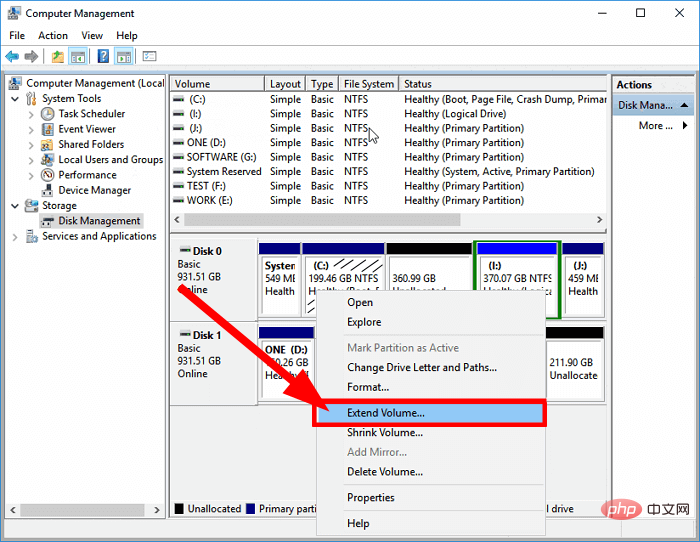 Operation and Maintenance
Operation and Maintenance Linux Operation and Maintenance
Linux Operation and Maintenance Best Practices: Performance Tuning Guide for Building a Web Server on CentOS
Best Practices: Performance Tuning Guide for Building a Web Server on CentOSBest Practices: Performance Tuning Guide for Building Web Servers on CentOS
Abstract: This article aims to provide some performance tuning best practices for users building web servers on CentOS, aiming to improve the performance of the server. and response speed. Some key tuning parameters and commonly used optimization methods will be introduced, and some sample codes will be provided to help readers better understand and apply these methods.
1. Turn off unnecessary services
When building a web server on CentOS, some unnecessary services will be started by default. These services will occupy system resources and have no obvious impact on the performance of the web server. promote. Therefore, we should shut down these unnecessary services to free up resources.
Use the following command to list the running services:
systemctl list-units --type=service --state=running
Choose to close unnecessary services according to the actual situation, such as turning off the mail service:
systemctl stop postfix systemctl disable postfix
2. Adjust the kernel parameters
Optimizing kernel parameters is an important step in improving server performance. Kernel parameters can be adjusted by modifying the /etc/sysctl.conf file. The following are some commonly used kernel parameter tuning solutions:
- Increase the limit on the number of file handles
# 增加系统最大文件句柄数 fs.file-max = 65535 # 增加每个进程可以打开的文件句柄数限制 ulimit -n 65535
- Increase the limit on the number of TCP connections
# 增加系统的最大并发TCP连接数 net.ipv4.ip_local_port_range = 1024 65535 net.ipv4.tcp_tw_reuse = 1 net.ipv4.tcp_tw_recycle = 1 net.ipv4.tcp_fin_timeout = 30 net.ipv4.tcp_max_tw_buckets = 5000 net.ipv4.tcp_max_syn_backlog = 1024 net.core.somaxconn = 65535
- Eliminate group chat fragmentation
# 消除群聊分片 net.ipv4.tcp_timestamps = 0 net.ipv4.tcp_sack = 0 net.ipv4.tcp_dsack = 0
- Increase the system TCP buffer size
# 提高TCP接收窗口缓冲区大小(单位:字节) net.ipv4.tcp_rmem = 4096 87380 4194304 # 提高TCP发送窗口缓冲区大小(单位:字节) net.ipv4.tcp_wmem = 4096 16384 4194304 # 提高系统的TCP连接跟踪表的大小 net.netfilter.nf_conntrack_max = 65536
After modifying the above parameters, use the following command to enable It takes effect:
sysctl -p
3. Use a high-performance web server
Choosing an appropriate web server also has an important impact on performance. On CentOS, Nginx and Apache are commonly used web servers.
- Nginx
Nginx is a high-performance HTTP and reverse proxy server that uses an asynchronous non-blocking event-driven architecture to easily handle large traffic requests.
Install Nginx:
yum install nginx
Configure Nginx:
Edit /etc/nginx/nginx.confFile:
user www-data;
worker_processes auto;
worker_cpu_affinity auto;
events {
worker_connections 1024;
use epoll;
multi_accept on;
}
http {
# 配置HTTP服务器
...
}- Apache
Apache is a feature-rich and widely used web server. Although its performance is slightly inferior to Nginx, it can still provide good performance in some specific scenarios.
Install Apache:
yum install httpd
Configure Apache:
Edit /etc/httpd/conf/httpd.confFile:
ServerLimit 2048 MaxClients 2048
4. Use cache acceleration
Using caching technology can effectively improve the performance of the web server. The following two methods can be used for cache acceleration:
- HTTP Cache
By setting the appropriate Cache-Control and ExpiresResponse header allows the client to cache static resources, reduce the load on the server, and improve the user's access experience. The sample code is as follows:
location /static {
expires 7d;
}- Reverse proxy cache
Use reverse proxy cache to cache dynamic content and reduce requests to the backend server. You can use Nginx's proxy_cache module to implement reverse proxy caching. The sample code is as follows:
proxy_cache_path /var/nginx/cache levels=1:2 keys_zone=my_cache:10m max_size=10g inactive=60m;
server {
...
location / {
proxy_cache my_cache;
proxy_cache_valid 200 301 302 5m;
proxy_pass http://backend;
}
}Conclusion
By closing unnecessary services, adjusting kernel parameters, using high-performance web servers and using cache acceleration, the web server built on CentOS can be better Good performance and responsiveness. I hope the performance tuning guide provided in this article will be helpful to you.
Reference link:
- https://www.digitalocean.com/community/tutorials/5-tips-to-speed-up-your-nginx-web-server
- https://www.digitalocean.com/community/tutorials/how-to-optimize-nginx-configuration
The above is the detailed content of Best Practices: Performance Tuning Guide for Building a Web Server on CentOS. For more information, please follow other related articles on the PHP Chinese website!
 centos用什么命令可查版本号Mar 03, 2022 pm 06:10 PM
centos用什么命令可查版本号Mar 03, 2022 pm 06:10 PM查版本号的命令:1、“cat /etc/issue”或“cat /etc/redhat-release”,可输出centos版本号;2、“cat /proc/version”、“uname -a”或“uname -r”,可输出内核版本号。
 centos重启网卡的方法是什么Feb 22, 2023 pm 04:00 PM
centos重启网卡的方法是什么Feb 22, 2023 pm 04:00 PMcentos重启网卡的方法:1、对于centos6的网卡重启命令是“service network restart”;2、对于centos7的网卡重启命令是“systemctl restart network”。
 centos php怎么安装opcacheJan 19, 2023 am 09:50 AM
centos php怎么安装opcacheJan 19, 2023 am 09:50 AMcentos php安装opcache的方法:1、执行“yum list php73* | grep opcache”命令;2、通过“yum install php73-php-opcache.x86_64”安装opcache;3、使用“find / -name opcache.so”查找“opcache.so”的位置并将其移动到php的扩展目录即可。
 centos 怎么离线安装 mysqlFeb 15, 2023 am 09:56 AM
centos 怎么离线安装 mysqlFeb 15, 2023 am 09:56 AMcentos离线安装mysql的方法:1、将lib中的所有依赖上传到linux中,并用yum命令进行安装;2、解压MySQL并把文件复制到想要安装的目录;3、修改my.cnf配置文件;4、复制启动脚本到资源目录并修改启动脚本;5、将mysqld服务加入到系统服务里面;6、将mysql客户端配置到环境变量中,并使配置生效即可。
 centos 7安装不出现界面怎么办Jan 03, 2023 pm 05:33 PM
centos 7安装不出现界面怎么办Jan 03, 2023 pm 05:33 PMcentos7安装不出现界面的解决办法:1、选择“Install CentOS 7”,按“e”进入启动引导界面;2、 将“inst.stage2=hd:LABEL=CentOS\x207\x20x86_64”改为“linux dd”;3、重新进入“Install CentOS 7”,按“e”将“hd:”后的字符替换成“/dev/sdd4”,然后按“Ctrl+x”执行即可。
 centos 怎么删除 phpFeb 24, 2021 am 09:15 AM
centos 怎么删除 phpFeb 24, 2021 am 09:15 AMcentos删除php的方法:1、通过“#rpm -qa|grep php”命令查看全部php软件包;2、通过“rpm -e”命令卸载相应的依赖项;3、重新使用“php -v”命令查看版本信息即可。
 centos中ls命令不显示颜色怎么办Apr 20, 2022 pm 03:16 PM
centos中ls命令不显示颜色怎么办Apr 20, 2022 pm 03:16 PM方法:1、利用“vim ~/.bashrc”编辑用户目录(~)下的“.bashrc”文件;2、在文件内添加“alias ls="ls --color"”;3、利用“:wq!”命令保存文件内的更改;4、“exit”命令退出终端后重新连接即可。
 如何在 CentOS 9 Stream 上安装 NagiosMay 10, 2023 pm 07:58 PM
如何在 CentOS 9 Stream 上安装 NagiosMay 10, 2023 pm 07:58 PM我们的PC中有一个磁盘驱动器专门用于所有与Windows操作系统相关的安装。该驱动器通常是C驱动器。如果您还在PC的C盘上安装了最新的Windows11操作系统,那么所有系统更新(很可能是您安装的所有软件)都会将其所有文件存储在C盘中。因此,保持此驱动器没有垃圾文件并在C驱动器中拥有足够的存储空间变得非常重要,因为该驱动器拥有的空间越多,您的Windows11操作系统运行起来就越顺畅。但是您可以在磁盘驱动器上增加多少空间以及可以删除多少文件是有限制的。在这种情况下,


Hot AI Tools

Undresser.AI Undress
AI-powered app for creating realistic nude photos

AI Clothes Remover
Online AI tool for removing clothes from photos.

Undress AI Tool
Undress images for free

Clothoff.io
AI clothes remover

AI Hentai Generator
Generate AI Hentai for free.

Hot Article

Hot Tools

MantisBT
Mantis is an easy-to-deploy web-based defect tracking tool designed to aid in product defect tracking. It requires PHP, MySQL and a web server. Check out our demo and hosting services.

Atom editor mac version download
The most popular open source editor

Dreamweaver Mac version
Visual web development tools

Notepad++7.3.1
Easy-to-use and free code editor

SublimeText3 English version
Recommended: Win version, supports code prompts!





